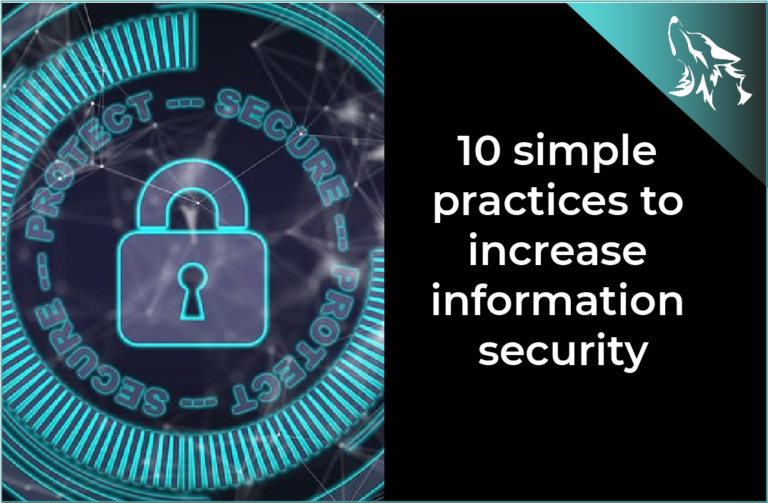Quick Overview
The protection of critical information is of crucial importance to any business. Hacking, data leaks and cyber threats are ubiquitous these days, which is why businesses should make information security a priority. In this blog post, we’ll share 10 simple and effective ways for your organization on how to strengthen information security.
1. Awareness raising and training of employees
It doesn’t matter how progressive and sophisticated your technical security measures are if employees are not adequately trained and sensitized. Cybercriminals deliberately manipulate employees through deception and seduction to obtain confidential information such as passwords. But even unintentional mistakes regarding data protection law made by employees can spell doom for a company and even result in legal consequences.
The first step in strengthening information security is therefore to inform all employees about the importance of security measures. Regular training and awareness measures help employees to become aware of potential dangers and to recognize them at an early stage. Sharing Best Practices in handling confidential data is also very beneficial.
IX Employee Training
We increase awareness and train your employees in an easy-to-understand way in all areas of information security – in presence or online.
2. Strengthen password security
Passwords are often the first point of defense against unauthorized access.However, common passwords such as 123456 or password123 are quickly cracked by hackers using automated tools. Companies should insist that employees use strong passwords, change them regularly, and store them securely. Password security can be increased by:
- A minimum length of 12 characters
- Upper and lower case letters
- Special characters
- No personal information such as pet names, etc.
- Use a separate password for each service
- Two-factor authentication via SMS or Authentificator app.
3. Security policies and procedures
Creating well-defined security policies and procedures is essential for companies. These policies should govern how to handle confidential information, access data, share information, and deal with security incidents. All employees should know and follow these policies.
Implementing security policies is an ongoing process and requires the cooperation of various departments within the company as well as the involvement of senior management. It is important that all employees understand the importance of the policies and contribute to creating a secure corporate environment. The policies should be part of the organization’s culture.
4. Periodic safety checks
The rapid changes in technology bring many benefits and opportunities, but new threats also emerge. Regular auditing of security systems is important to uncover and address potential vulnerabilities and security gaps.
Penetration tests and security audits can help identify and eliminate security gaps early on. At the same time, they serve as an emergency exercise and prepare the company for the procedures in the event of an emergency.
Achieving certifications, such as the ISO 27001 standard, demonstrates your company’s commitment to information security and that you meet a higher standard. This can have a positive impact on your competitiveness and business partnerships.
NORM X for ISO 27001
ISO 27001 is considered the “state of the art” certification for information security for companies in an (inter)national context.
Protect your companies demonstrably with the certification!
5. Up to date software and patches
Your organization should ensure that all software is up to date and that all security patches are installed in a timely manner. Outdated software can be an easy target for attackers and pose potential security risks. In most cases, settings can be selected to run updates automatically. This way, there is no additional effort for the (IT) staff.
6. Access rights restriction
Not all employees need access to types of information. Restricting access rights on a “need-to-know” basis significantly reduces the risk of unauthorized access. As a result, employees are only given access to the relevant information in order to carry out their activities. This minimizes data leaks, data breaches and the risk of internal data misuse.
7. Data storage and deletion
The way data is stored and deleted is critical. Companies should ensure that all data is securely encrypted when stored and that obsolete or no longer needed data is properly and permanently deleted. Likewise, integrity should be maintained – that is, protection against unauthorized modification of data. Integrity, together with availability and confidentiality, is one of the three protection goals of information security.
8. Use of firewalls and antivirus software
Firewalls and antivirus software are basic security measures that can protect against many cyber threats. It is important that this software is installed on all relevant devices and updated regularly (see also point 5). Using real-time protection and scans will prevent malicious files from entering and running on the system.
In addition, the antivirus software should use regularly updated malware databases to detect current threats. Without up-to-date signatures, certain malware types might remain undetected.
9. Safety when handling external devices
Handling external devices such as USB sticks or external hard drives should be carried out with caution. Organizations can implement policies for the secure handling of such devices to minimize the risk of data loss or theft. Three examples for regulations are:
- Ban on unauthorized external devices: There should be a regulation stating that the use of unauthorized external devices on the corporate network is prohibited. Employees should only be allowed to use approved and verified USB sticks or hard drives to ensure that they do not contain malware.
- Scan for malware: Before an external device is plugged into the corporate network, it should be compulsorily scanned for malware. This can be done either by the IT department or by special security software.
- Data encryption for external devices: There should be a guideline stating that all data on external devices such as USB sticks or hard drives must be encrypted. This ensures that even if the device is lost or stolen, the data stored on it cannot be accessed by unauthorized persons.
9. Safety when handling external devices
Regular backups of all important company data should be performed regularly. This allows the company to restore its data and quickly resume business operations in the event of a security incident. This ensures the continuity strategy.
For many companies, backup storage in a cloud service is the best solution, as it offers many advantages such as scalability or automation. Together with our partner BackupONE, we also offer our customers a cloud backup solution with data storage 100% in Switzerland.
Backup Service BackupONE
The ISEGRIM X® Cyber Protect solution integrates and automates cyber security and backup to comprehensively protect your endpoints, systems and data while still keeping total cost of ownership low.
10. Conclusion
Increasing information security in a company does not require complex measures. Through a combination of employee awareness, well-defined security policies, and the use of basic security technologies, companies can protect their data from potential threats. By implementing these ten simple steps, your company can strengthen information security and maintain or even foster customer and partner trust.


